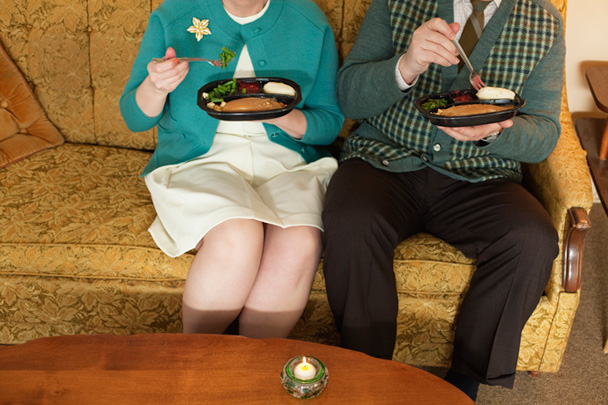A family of four gathers in the living room, eyes trained on their wood-grain television set while Lucille Ball dances across the screen. Brother and sister sit side by side on the floor, foil tray in their laps, devouring buttered peas and crispy fried chicken. Mom and Dad are nestled on the sofa, enjoying juicy Salisbury steaks, all ready in 25 minutes.
How was Mom able to prepare these meals so swiftly? The answer involves an adroit businessman and a serendipitous turkey surplus in the fall of 1953.
According to the most commonly told—although occasionally refuted—version of the story, when C.A. Swanson & Sons, the frozen-food purveyors, vastly overestimated the popularity of Thanksgiving turkey, brothers Gilbert and Clarke Swanson, who ran the company, were left with 260 tons of bird to spare. They had no room to store the excess, so they loaded the nearly half a million pounds of poultry onto ten refrigerated train cars that had to keep moving continuously so the electricity would stay on. Clearly, this wasn’t the most efficient solution. The Swanson brothers challenged their employees to come up with an alternate use for the meat.
While the frozen turkeys rode the rails, Gerry Thomas, a shrewd Swanson & Sons salesman, traveled from his company’s base in Nebraska to the kitchens of Pan American Airways in Pittsburgh. At the time, Pan Am was testing single-compartment foil trays used to serve warm in-flight meals to passengers. Thomas “borrowed” one of the trays (conveniently slipping it into his coat pocket) and spent his return trip drawing up plans for a three-compartment version that would ensure that peas and gravy would never touch each other.
Thomas suggested that the Swansons fill his revamped tray with Thanksgiving dinners. His truly breakthrough idea, however, was in the marketing. He made the trays TV-themed, capitalizing on the latest craze: Americans were hooked on TV, with a set in 33 million households by 1953. The original “TV Brand Frozen Dinner,” as it was called, was packaged in a box designed to look like a TV, complete with volume knobs and the food featured as the screen. The first TV dinner, sold in 1954, cost 98 cents and contained corn bread stuffing, peas, sweet potatoes, and, of course, turkey. (The dessert didn’t appear until 1960, so Mom was still responsible for the sweets.) Swanson initially ordered 5,000 dinners—which were assembled by two dozen women, armed with spatulas and ice cream scoops. By the end of the first full year of production, Swanson had sold ten million TV dinners.
Although Thomas is often credited as the “Father of the TV dinner,” he didn’t invent the concept of the frozen meal. Maxson Food Systems had developed that nearly a decade earlier, in 1945. Maxson’s “Strato-Plates” were served on airplanes but they never reached the retail market.
Quaker State Foods was the first to feature the frozen meal in supermarkets under its “One-Eyed Eskimo” label in 1949. Frozen dinners were also available at bars and taverns, courtesy of Jack Fisher’s FridgiDinner, but washing down prepackaged meatloaf with a pint of lager didn’t catch on the way Swanson’s dinner did.
Thomas recalls in a 1999 interview with the AP news agency, “I think the name made all the difference in the world.” Due to Swanson’s brand notoriety, expansive advertising campaign, and catchy concept, Swanson’s TV dinner altered the way people approached frozen food. Thomas said, “It’s a pleasure being identified as the person who did this because it changed the way people live.”
The TV dinner gave women (who were predominantly the family cooks) more free time to pursue jobs and other activities while still providing a hot meal for their families. One of the first advertisements featured a stylish wife right out of a Mad Men scene, pulling a Swanson dinner out of her grocery bag and insisting to her husband, “I’m late—but dinner won’t be.” Food historian Megan Elias said in an e-mail interview, “The big issue was that by the end of World War II, middle-class women could no longer rely on maids to help out in the kitchen, so having a meal ready-made was a way to re-create that feeling of being served, which had been common in middle-class homes in the earlier part of the century.”
Not everyone was keen on the TV dinner, especially the occasional displeased husband. Thomas told the Associated Press in 1999 that he received hate mail from gentlemen saying they “wanted their wives to cook from scratch like their mothers did.” Also, not every critic was fond of the flavors. Journalist Betty Wason wrote in her book Cooks, Gluttons & Gourmets in 1962, “TV dinners had as much succulence as half-baked tissue paper.” Gerry Thomas abstained from the meals, too. According to the BBC, Thomas’ wife admitted that he was a gourmet cook (lucky for Susan) who never ate the dinners. Even if you weren’t a fan of the buttered beef steak, when the dinner was first introduced it held a certain social cachet because it was associated with the television—something that only the middle and wealthier classes had access to in the early days.
Over the past 40 years, the success of the frozen meal has continued to be driven by deft marketing and flashy packaging, from the seductive illustrations of 1950s-era fashionistas, to the promise of succulent Applebee’s Buffalo Wings in eight minutes. Although Swanson dropped the iconic name in 1962 and you’ll have to visit the Smithsonian to see an original aluminum tray (microwavable plastic containers are the game these days), most Americans will always call these meals a TV dinner. To see our reinvention of the TV dinner, check out Kemp Minifie’s TV dinner recipes.

